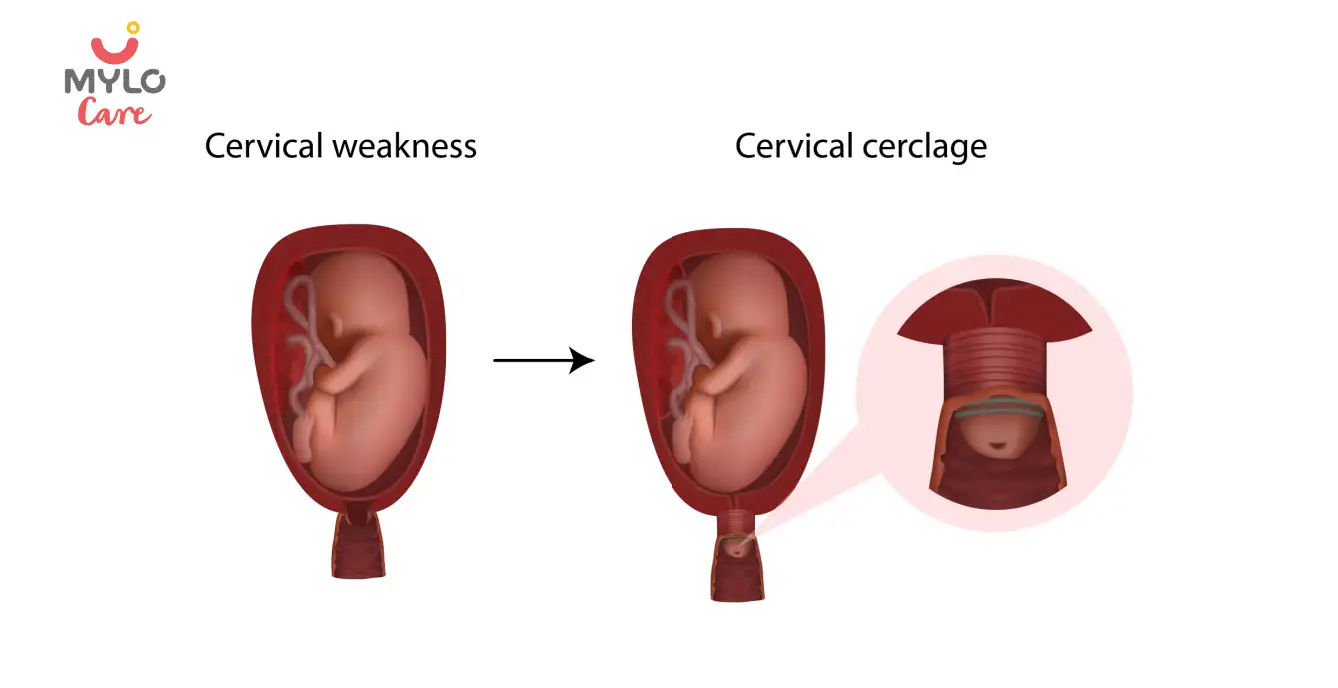Get MYLO APP
Install Mylo app Now and unlock new features
💰 Extra 20% OFF on 1st purchase
🥗 Get Diet Chart for your little one
📈 Track your baby’s growth
👩⚕️ Get daily tips

OR


Article Continues below advertisement
- Home

- Normal Ovary Size: How It Varies and What It Means for You
In this Article
- What is the normal size of an ovary?
- What is the normal ovary size by age?
- What are the causes of an abnormal ovary size?
- 1. Polycystic Ovary Syndrome (PCOS)
- 2. Ovarian cysts
- 3. Ovarian tumors
- 4. Endometriosis
- 5. Ovarian hyperstimulation syndrome (OHSS)
- 6. Pelvic inflammatory disease (PID)
- 7. Hormonal imbalances
- What are the factors affecting the normal ovary size?
- 1. Age
- 2. Hormonal fluctuations
- 3. Pregnancy
- 4. Body weight
- 5. Genetics
- 6. Menopause
- 7. Medical conditions
- How to achieve the normal size of ovary to get pregnant?
- 1. Maintain a healthy weight
- 2. Manage stress levels
- 3. Regular exercise
- 4. Balanced diet
- 5. Seek medical advice
- FAQ’S
- 1. What is the right ovary normal size in cm?
- 2. What is the left ovary normal size in cm?
- 3. What should be the normal size of ovary to get pregnant?
- The Bottomline
- References

Getting Pregnant
Normal Ovary Size: How It Varies and What It Means for You
Updated on 4 December 2023
The size of our organs often goes unnoticed, as our bodies have an incredible ability to adapt and function without our conscious awareness. However, when it comes to our reproductive health, understanding the size and condition of our ovaries becomes crucial. The ovaries, those small yet mighty organs, play a vital role in our fertility and overall well-being. Consequently, it’s essential to understand the normal ovary size and the factors affecting it.
What is the normal size of an ovary?
The normal size of an ovary is typically measured in millimeters, with the dimensions of length, width, and thickness being taken into account. A normal ovary size in mm is usually around 30mm long, 25mm wide, and 15mm thick. During a woman's reproductive years, the average size of an ovary ranges from 3 to 5 centimeters in length and 1.5 to 3 centimeters in width.
Accordingly, the right ovary normal size in cm and the left ovary normal size in cm should be around 3.5 centimeters (35 mm) in length, 2 centimeters (20 mm) in width, and 1.5 centimeters (15 mm) in thickness.
Article continues below advertisment
Generally, the size of an ovary can vary based on several factors, such as age, hormonal fluctuations, and overall health. It's important to note that there can be slight variations in size among individuals, and what may be considered normal for one person might be slightly different for another.
What is the normal ovary size by age?
The size of the ovaries can differ depending on the age of a woman. In early childhood and before puberty, the ovaries are usually small in size, measuring around 1 to 1.5 centimeters.
As a girl enters puberty and starts menstruating, her ovaries gradually increase in size. During the reproductive years, which typically span from the late teens to the late 40s, the ovaries reach their maximum size. As mentioned earlier, the average size during this period is around 3 to 5 centimeters in length and 1.5 to 3 centimeters in width.
As menopause approaches, the ovaries tend to shrink in size due to decreased hormone production. Postmenopausal ovaries are usually smaller, measuring around 1 to 2 centimeters.
You may also like: Bulky Ovaries Explained: What Every Woman Should Be Aware Of
Article continues below advertisment
What are the causes of an abnormal ovary size?
Let us understand some reasons which may cause the ovarian size to fluctuate from the normal:
1. Polycystic Ovary Syndrome (PCOS)
A common hormonal disorder that can cause enlarged ovaries due to the formation of multiple small cysts.
2. Ovarian cysts
Fluid-filled sacs that can develop on the ovaries, leading to an increase in their size.
3. Ovarian tumors
Both benign and malignant tumors can cause abnormal growth of the ovaries.
4. Endometriosis
A condition where the tissue lining the uterus grows outside of it, which can affect the size and function of the ovaries.
Article continues below advertisment
5. Ovarian hyperstimulation syndrome (OHSS)
A side effect of fertility treatments that can cause the ovaries to become enlarged.
6. Pelvic inflammatory disease (PID)
Infections in the reproductive organs can lead to inflammation and swelling of the ovaries.
7. Hormonal imbalances
Fluctuations in hormone levels can affect the size of the ovaries.
What are the factors affecting the normal ovary size?
The normal ovary size in mm can vary due to the following factors:
1. Age
As mentioned earlier, the normal ovary size by age also varies.
Article continues below advertisment
2. Hormonal fluctuations
Changes in hormone levels, such as those that occur during the menstrual cycle, can impact the size of the ovaries.
3. Pregnancy
The ovaries can temporarily increase in size during pregnancy due to hormonal changes and the development of the growing fetus.
4. Body weight
Studies have shown a correlation between body weight and ovarian size, with overweight and obese individuals tending to have larger ovaries.
5. Genetics
Genetic factors can influence the size and overall structure of the ovaries.
6. Menopause
As women approach menopause, the ovaries naturally decrease in size due to hormonal changes.
Article continues below advertisment
7. Medical conditions
Certain medical conditions, such as PCOS and endometriosis, can affect the size of the ovaries.
How to achieve the normal size of ovary to get pregnant?
If you’re trying to conceive, then here are some tips that may help you achieve the normal ovarian size:
1. Maintain a healthy weight
Excess body weight can contribute to hormonal imbalances and affect the size of the ovaries. Aim to achieve and maintain a healthy weight through a balanced diet and regular exercise.
2. Manage stress levels
Chronic stress can disrupt hormone production and impact the size and function of the ovaries. Practice stress-management techniques such as meditation, yoga, or engaging in hobbies you enjoy.
3. Regular exercise
Engaging in regular physical activity can help regulate hormone levels and promote overall reproductive health. Aim for at least 150 minutes of moderate-intensity exercise per week.
Article continues below advertisment
4. Balanced diet
Ensure your diet includes a variety of nutrient-rich foods, such as fruits, vegetables, whole grains, lean proteins, and healthy fats. A well-balanced diet can support hormonal balance and optimal ovarian function.
5. Seek medical advice
If you have concerns about your ovary size or fertility, consult with a healthcare professional. They can provide personalized guidance and recommend appropriate tests or treatments if necessary.
You may also like: Ovarian Stimulation: Understanding the Process and What to Expect
FAQ’S
1. What is the right ovary normal size in cm?
The right ovary, like the left ovary, can vary in size depending on individual factors. On average, the right ovary measures around 3 to 5 centimeters in length and 1.5 to 3 centimeters in width during the reproductive years. However, it's important to remember that there can be slight variations in size among individuals that still fall within the normal range.
2. What is the left ovary normal size in cm?
Similar to the right ovary, the left ovary's normal size falls within the range of 3 to 5 centimeters in length and 1.5 to 3 centimeters in width during the reproductive years. However, as with any organ, individual variations are possible, and the specific measurements may differ slightly while still being considered normal.
Article continues below advertisment
3. What should be the normal size of ovary to get pregnant?
In general, during the reproductive years, the ovaries typically measure around 3-5 centimeters in length. Ovarian size can change during the menstrual cycle, with ovaries being larger and more active during the follicular phase (before ovulation) and slightly smaller during the luteal phase (after ovulation).
The Bottomline
Understanding the normal ovary size is crucial for assessing reproductive health. While the average size falls within the range of 3 to 5 centimeters in length and 1.5 to 3 centimeters in width during the reproductive years, slight variations can occur among individuals. If you have concerns about your ovary size or fertility, it is recommended to consult with a healthcare professional who can provide personalized guidance based on your specific circumstances.
References
1. Kelsey TW, Dodwell SK, Wilkinson AG, Greve T, Andersen CY, Anderson RA, Wallace WH. (2013). Ovarian volume throughout life: a validated normative model. PLoS One.
2. Pavlik EJ, DePriest PD, Gallion HH, Ueland FR, Reedy MB, Kryscio RJ, van Nagell JR Jr. (2000). Ovarian volume related to age. Gynecol Oncol.
Article continues below advertisment



Written by
Anandita Sharma
Drawing on more than a decade of expertise in administration, Anandita Sharma currently serves as a content operations e
Read MoreGet baby's diet chart, and growth tips

Related Articles
Related Questions
Hello frnds..still no pain...doctor said head fix nhi hua hai..bt vagina me pain hai aur back pain bhi... anyone having same issues??
718 views
Kon kon c chije aisi hai jo pregnancy mei gas acidity jalan karti hain... Koi btayega plz bcz mujhe aksar khane ke baad hi samagh aata hai ki is chij se gas acidity jalan ho gyi hai. Please share your knowledge
727 views
I am 13 week pregnancy. Anyone having Storione-xt tablet. It better to have morning or night ???
730 views
Hlo to be moms....i hv a query...in my 9.5 wk i feel body joint pain like in ankle, knee, wrist, shoulder, toes....pain intensity is high...i cnt sleep....what should i do pls help....cn i cosult my doc.
733 views
Influenza and boostrix injection kisiko laga hai kya 8 month pregnancy me and q lagta hai ye plz reply me
743 views
RECENTLY PUBLISHED ARTICLES
our most recent articles

Festivals & Celebrations
2024 Calendar with Holidays and Festivals of India

Abortion
After-Abortion Sex: A Guide to Physical and Emotional Wellness

Premature Delivery
Cervical Cerclage: A Closer Look at the Procedure and Its Benefits

Stories
The Ultimate Guide to Panchatantra Stories for Kids

Labour & Delivery
Which Is Better Normal Or Cesarean Delivery

Fetal Growth
How to Get Baby in Right Position for Birth?
- Paheliyan 101: Riddles for Kids That Educate and Entertain
- The ABCs of Cephalic Presentation: A Comprehensive Guide for Moms-to-Be
- The Ultimate Guide to Consuming Chia Seeds in Pregnancy
- Essential Tips for Normal Delivery After Cesarean
- Crab During Pregnancy: Benefits, Risks and Smart Choices
- Normal Delivery Tips: An Expecting Mother's Guide to a Smooth Childbirth Experience
- Top 10 Panchatantra Stories in English You Must Read to Your Children
- What Helps in Improving Mental Health of Women
- Childhood Disorders: Meaning, Symptoms & Treatment
- Bleeding During Pregnancy 8 Weeks: Should You See a Doctor?
- The Ultimate Guide to Having Sex After C Section
- The Ultimate Guide to Baby Brain Development Food During Pregnancy
- Nappy Rash: Your Ultimate Guide to Symptoms and Quick Relief
- How to Get Periods Immediately to Avoid Pregnancy?


AWARDS AND RECOGNITION

Mylo wins Forbes D2C Disruptor award

Mylo wins The Economic Times Promising Brands 2022
AS SEEN IN
















- Mylo Care: Effective and science-backed personal care and wellness solutions for a joyful you.
- Mylo Baby: Science-backed, gentle and effective personal care & hygiene range for your little one.
- Mylo Community: Trusted and empathetic community of 10mn+ parents and experts.
Product Categories
baby carrier | baby soap | baby wipes | stretch marks cream | baby cream | baby shampoo | baby massage oil | baby hair oil | stretch marks oil | baby body wash | baby powder | baby lotion | diaper rash cream | newborn diapers | teether | baby kajal | baby diapers | cloth diapers |





